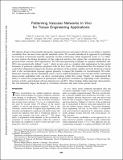Patterning Vascular Networks In Vivo for Tissue Engineering Applications
Author(s)
Chaturvedi, Ritika R.; Solorzano, Ricardo D.; Eyckmans, Jeroen; Baranski, Jan D.; Stapleton, Sarah Chase; Stevens, Kelly R.; Bhatia, Sangeeta N; Chen, Christopher S.; Schwartz, Robert E.; ... Show more Show less
DownloadPatterning vascular networks.pdf (1.333Mb)
PUBLISHER_POLICY
Publisher Policy
Article is made available in accordance with the publisher's policy and may be subject to US copyright law. Please refer to the publisher's site for terms of use.
Terms of use
Metadata
Show full item recordAbstract
The ultimate design of functionally therapeutic engineered tissues and organs will rely on our ability to engineer vasculature that can meet tissue-specific metabolic needs. We recently introduced an approach for patterning the formation of functional spatially organized vascular architectures within engineered tissues in vivo. Here, we now explore the design parameters of this approach and how they impact the vascularization of an engineered tissue construct after implantation. We used micropatterning techniques to organize endothelial cells (ECs) into geometrically defined “cords,” which in turn acted as a template after implantation for the guided formation of patterned capillaries integrated with the host tissue. We demonstrated that the diameter of the cords before implantation impacts the location and density of the resultant capillary network. Inclusion of mural cells to the vascularization response appears primarily to impact the dynamics of vascularization. We established that clinically relevant endothelial sources such as induced pluripotent stem cell-derived ECs and human microvascular endothelial cells can drive vascularization within this system. Finally, we demonstrated the ability to control the juxtaposition of parenchyma with perfused vasculature by implanting cords containing a mixture of both a parenchymal cell type (hepatocytes) and ECs. These findings define important characteristics that will ultimately impact the design of vasculature structures that meet tissue-specific needs.
Date issued
2015-02Department
Massachusetts Institute of Technology. Institute for Medical Engineering & Science; Massachusetts Institute of Technology. Institute for Medical Engineering & Science; Harvard University--MIT Division of Health Sciences and Technology; Massachusetts Institute of Technology. Department of Electrical Engineering and Computer ScienceJournal
Tissue Engineering Part C: Methods
Publisher
Mary Ann Liebert, Inc.
Citation
Chaturvedi, Ritika R., Kelly R. Stevens, Ricardo D. Solorzano, Robert E. Schwartz, Jeroen Eyckmans, Jan D. Baranski, Sarah Chase Stapleton, Sangeeta N. Bhatia, and Christopher S. Chen. “Patterning Vascular NetworksIn Vivofor Tissue Engineering Applications.” Tissue Engineering Part C: Methods 21, no. 5 (May 2015): 509–517.
Version: Final published version
ISSN
1937-3384
1937-3392